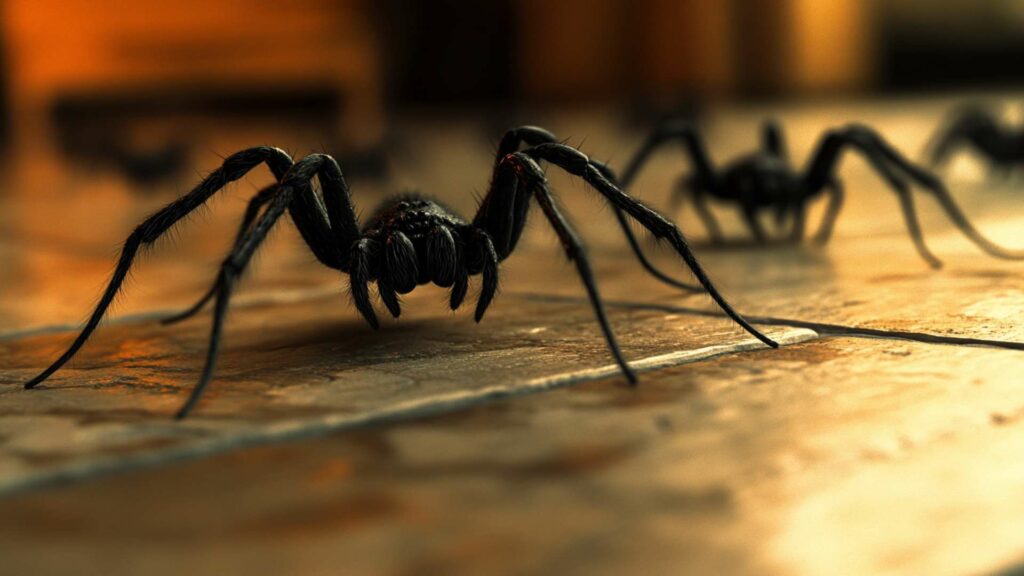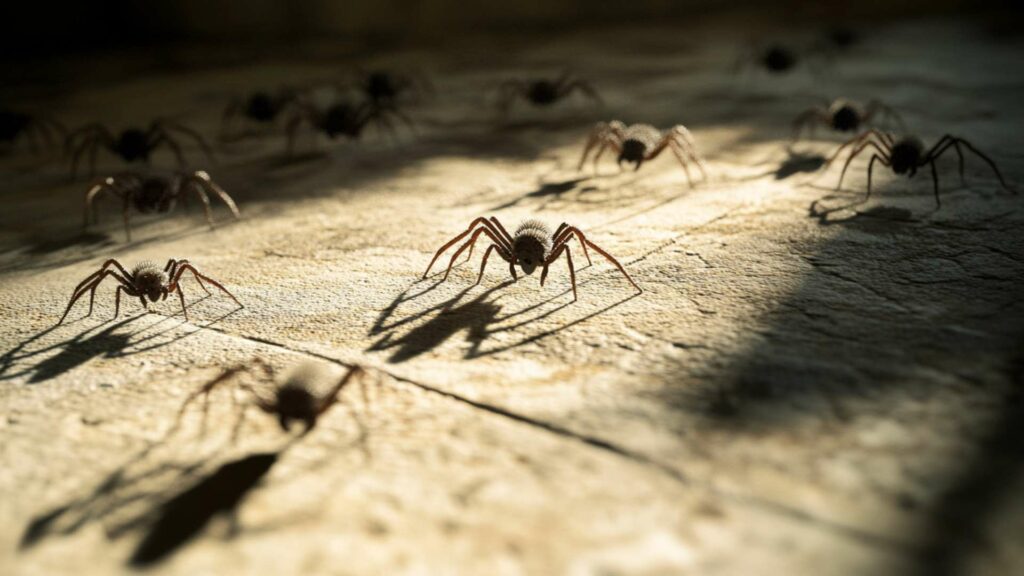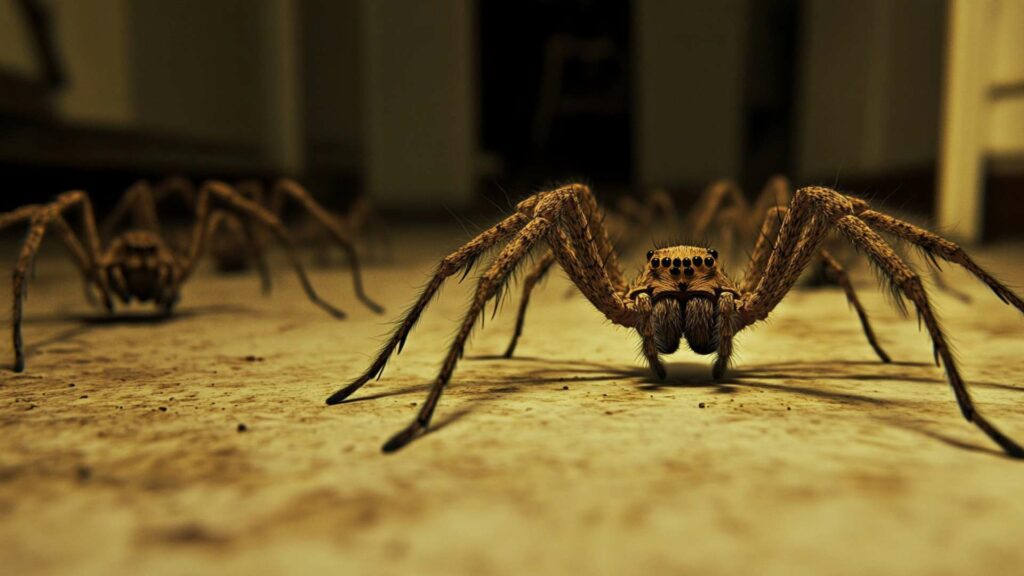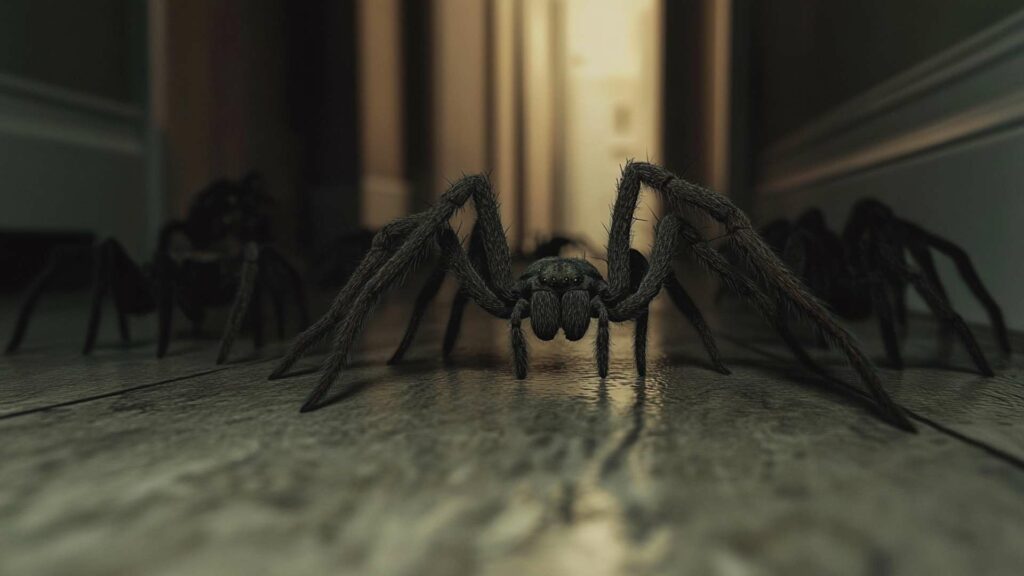Ah, the intriguing world of spiders – those eight-legged wonders that simultaneously fascinate and frighten us. These small arachnids have captured our imagination for centuries with their delicate webs, their stealthy hunting techniques, and their unique physiology. But amidst our admiration for these incredible creatures, a peculiar question emerges: Can spiders get high?
Before we dive into the depths of this thought-provoking topic, let’s take a moment to appreciate the remarkable characteristics that make spiders such captivating creatures. With over 47,000 species worldwide, each one possesses its own set of extraordinary features.
From the mesmerizing orb-weaving patterns to their multifaceted eyes that grant them a panoramic view of their surroundings, spiders are intricate beings indeed. But what sets them apart even more is their uncanny ability to produce silk – a skill unmatched in the animal kingdom.
Spiders possess specialized glands in their abdomen that secrete liquid silk proteins which harden into solid threads upon exposure to air. This remarkable substance serves various purposes, including building webs for trapping prey or constructing shelters where they can lay eggs.
Now comes the thought-provoking question: Can spiders get high? The notion of spiders high? may seem far-fetched at first glance; however, it’s not entirely baseless.
After all, there exist numerous plants and fungi in nature capable of altering an organism’s mind and behavior when consumed or interacted with. We humans have long sought such experiences ourselves through mind-altering substances like LSD or cannabis.
So could it be possible that these curious arthropods could also partake in a similar state? Intrigued by this peculiar possibility?
Well then, let us embark on an enthralling journey through spider biology and neurobiology as we explore whether our arachnid friends can truly experience altered states of consciousness. Get ready to uncover fascinating research, captivating anecdotes, and unexpected spider drug preferences – because the realm of stoned spiders might just be more than a web of imagination.
The Intricate World of Spiders: Beyond Eight Legs

Spiders, those fascinating arachnids that often send shivers down our spines, possess an intricate and highly specialized anatomy. With their eight legs, they navigate the world with remarkable agility. But their physical attributes go well beyond the number of limbs they possess.
Spiders have an exoskeleton that provides support and protection while allowing flexibility in movement. Underneath this exoskeleton lies a complex internal structure consisting of organs such as the digestive and human nervous system,, reproductive organs, and even a sophisticated respiratory system called book lungs.
But what truly sets spiders apart is their extraordinary sensory perception. While their eyesight is generally limited to detecting light and darkness, they make up for it through an acute sense of touch and vibration detection using tiny hairs located on their legs.
These sensory receptors allow them to perceive changes in their surroundings with astonishing precision. Additionally, spiders can detect chemicals in the air using specialized sensors called chemoreceptors located on their legs or mouthparts.
Weaving Wonders: Spider Webs as Works of Art

Spider webs are masterpieces of natural engineering that serve various purposes for these skilled arachnids. The process begins with spinning silk threads produced by glands located at the rear end of a spider’s abdomen. These silks can vary in thickness depending on the desired function of the web—some are sticky to trap prey while others provide structural support.
Web-building is a remarkable behavior that varies among different spider species. Some spiders construct orb-shaped webs suspended between trees or other structures, meticulously arranging radial threads connected by sticky spiral threads where unsuspecting insects become entangled.
Others prefer more labyrinthine designs like tangled cobwebs found in dark corners or abandoned buildings. Apart from web-building behaviors, spiders are also proficient hunters capable of employing various techniques to secure their next meal.
Some employ a sit-and-wait strategy, patiently lurking in hidden locations until a potential prey item comes within striking distance. Others actively chase down their prey, relying on their agility and venomous bites to incapacitate unfortunate victims.
The Art of Survival: Spider Behavior and Chemical Defense
Spider behavior extends beyond web-building and hunting techniques. These creatures have also evolved fascinating mechanisms for self-defense, including chemical defenses that can deter predators or repel parasites. While not all spiders possess venom potent enough to harm humans, many species produce venom containing an array of chemicals.
The influence of mind-altering substances on spiders’ behaviors is a captivating topic. Although research in this area is limited, anecdotes occasionally circulate about spiders exhibiting unusual behaviors after exposure to certain chemicals or drugs, sparking intrigue and speculation among enthusiasts.
However, it is important to approach such claims with caution until further scientific evidence emerges. Spiders’ biology and behavior exemplify the complexity that lies within these seemingly ordinary creatures.
From their intricate anatomy and sensory perception to the awe-inspiring artistry of their webs and hunting strategies, spiders continuously amaze us with their sublime adaptations for survival in the natural world. Note: While the topic of mind-altering substances will be discussed further in subsequent sections, this section serves as an introduction to spider biology and behavior without delving into specific psychoactive influences just yet.
Introduction to the Intricate Spider Nervous System
Spiders, remarkable arachnids, possess a captivatingly complex nervous system that allows them to navigate their intricate world. Despite their small size, these eight-legged creatures have a surprisingly sophisticated network of sensory organs and neurons.
Their nervous systems consist of a central brain and several ganglia distributed throughout their bodies. This organization enables spiders to process information rapidly and react swiftly to stimuli in their environment.
The Silk Secret: Specialized Glands for Production
One of the most fascinating aspects of spider neurobiology is their ability to produce silk through specialized glands. These remarkable creatures possess silk glands located in their abdomen that secrete liquid proteinaceous material called fibroin.
This liquid silk is then extruded through spinnerets, specialized structures present at the posterior end of the abdomen. Spider silk is renowned for its strength and versatility, allowing spiders to construct elaborate webs or create safety lines to navigate treacherous terrain.
The Role of Neurochemicals in Spider Behavior
Various neurochemicals play a crucial role in shaping spider behavior. For instance, studies have shown that certain chemicals can influence web-building patterns or hunting strategies. Researchers investigating this field have discovered that spiders possess cannabinoid receptors, just like humans do.
Interestingly enough, these receptors respond not only to cannabis-based compounds but also to other chemicals found naturally or artificially in our surroundings. These neurochemicals affect spiders’ behaviors differently depending on the specific compound and its concentration.
Some substances may induce hyperactivity while others might cause sedation or altered perception. For example more toxic the chemical is, chloral hydrate has been used experimentally as an anesthetic for spiders; when exposed to this chemical, they become temporarily lethargic or still.
Understanding the intricacies of spider neurobiology helps shed light on whether they can indeed get “high.” While some anecdotal evidence suggests that spiders might exhibit unusual behaviors after exposure to certain chemicals, more research is needed to determine the exact effects and their significance. Nonetheless, the remarkable ways in which these creatures perceive and interact with their environment continue to captivate scientists and nature enthusiasts alike.
Psychoactive Substances Found in Plants, Fungi, and Insects
When it comes to psychoactive substances, nature is full of surprises. Various plants, fungi, and even insects produce toxic compounds that can affect the behavior of animals, including humans.
Take plants like cannabis (commonly known as weed) and opium poppies, for instance. These plants contain chemicals such as THC and opioids that have mind-altering effects when consumed.
Additionally, certain mushrooms like Psilocybe cubensis produce compounds like psilocybin that induce hallucinations. Even the humble garden spider contains venom with neurotoxic properties.
Examples of Natural Compounds Affecting Behavior

Nature’s pharmacopeia is vast and diverse. Some natural compounds can profoundly influence an organism’s behavior upon ingestion or exposure.
For instance, caffeine found in coffee beans is a well-known stimulant that boosts alertness in humans. Similarly, nicotine from tobacco leaves acts as a potent addictive substance affecting both the brain and body.
Moving away from plants and into the insect world, we find species like ants that employ formic acid as a defensive mechanism to ward off predators or intruders. One intriguing example involves mescaline—the primary psychoactive compound found in certain cacti like Peyote—that induces hallucinations similar to those caused by LSD but with different characteristics.
This substance has attracted significant attention among researchers interested in understanding its impact on human consciousness. Researching these substances not only enhances our understanding of their ecological roles but also unearths potential applications for medical purposes or even space exploration—an area where NASA has shown interest through their publication “Nasa Tech Briefs.” Exploring these natural compounds helps us better grasp the intricate connections between different species and their unique chemical profiles.
In the next sections of this article, we will delve into the fascinating question of whether spiders can get high and how psychoactive substances might affect their behavior and web-building abilities. It’s time to untangle the web of curiosity surrounding these eight-legged creatures and their interaction with mind-altering substances.
Spider-Drug Interactions: Fact or Fiction?
As bizarre as it may sound, there have been numerous accounts of spiders displaying unusual behaviors after being exposed to psychoactive substances. These tales range from spiders spinning intricate and unconventional webs to exhibiting erratic movements and seemingly altered sensory perception.
One popular story involves a group of spiders accidentally exposed to chemical compounds in a laboratory, which led to the creation of fascinating and intricate spider web patterns that deviated significantly from their usual designs. While these anecdotes are captivating, it is important to approach them with skepticism.
Anecdotal evidence lacks scientific rigor and can be influenced by subjective interpretations or misinterpretation of events. Therefore, it is crucial to examine scientific studies that investigate spider reactions towards psychoactive substances in order to separate fact from fiction.
Scientific Studies: Unveiling Spider Responses to Psychoactive Substances
In recent years, researchers have delved into the effects of psychoactive substances on various organisms, including our eight-legged friends. One notable study carried out by NASA scientists explored the behavioral responses of spiders when exposed to mind-altering substances such as mescaline and chloral hydrate.
In this study conducted by NASA’s Image Processors team, arachnids were carefully administered controlled doses of these substances. The effects observed were indeed intriguing; some spiders displayed altered movement patterns while others exhibited heightened aggression or unusual web-building behavior.
These findings suggest that psychoactive substances can indeed impact spider behavior. Another notable investigation was led by Dr. Peter Witt at the University of Hamburg in Germany.
His research focused on exploring how arachnids respond specifically to cannabinoids, compounds known for their mind-altering properties present in marijuana plants. While his experiments provided interesting insights into spider neurobiology and the presence of cannabinoid receptors in their systems, the direct effects of cannabinoids on spider behavior were inconclusive.
While there is intriguing anecdotal evidence suggesting that spiders can be affected by psychoactive substances, it is crucial to rely on scientifically rigorous studies to assess the true impact. These studies provide a more accurate understanding of how mind-altering substances influence spider behavior and shed light on the intricate web of interactions between chemicals and arachnids’ intricate lives.
How drugs might impact a spider’s ability to build intricate webs
When it comes to the impact of drugs on spiders’ web-building abilities, it’s important to note that studies in this area are still relatively limited. However, some fascinating research has been conducted that sheds light on this intriguing topic.
One of the main questions is whether psychoactive substances can affect spiders’ ability to build their intricate, symmetrical webs. Web-building is an incredibly complex process for spiders, requiring precision and coordination.
It involves a delicate interplay between the spider’s brain and its silk-producing glands. When exposed to certain chemicals or drugs, this meticulous process may be disrupted or altered due to the potential effects on the spider’s cognitive abilities or nervous system.
Exploration of studies examining web-building behaviors under the influence
In order to understand how drugs might impact spiders’ web-building abilities, scientists have conducted various experiments with different chemicals other drugs, and substances. For instance, researchers at NASA were curious about how spiders would construct their webs after being exposed to different psychoactive compounds like caffeine and marijuana. One study involved feeding garden spiders a solution containing known concentrations of these substances mixed with sugar water.
The researchers then observed how these altered states may affect web construction patterns. They found that when exposed to low levels of caffeine, the spiders became more active and constructed webs with larger gaps between threads, whereas higher levels of caffeine seemed to impair their web-building capabilities with large gaps.
Similarly, when exposed to small amounts of marijuana compounds (similar to what might be found in plants), some spiders showed signs of decreased focus and attention span while building their webs. Some even left their webs unfinished or started weaving irregular patterns instead of their typical symmetrical designs.
Overall, these studies suggest that psychoactive substances can indeed impact spiders’ web-building abilities, although the effects may vary depending on factors such as the dosage, specific chemical compounds, and individual spider species. While still an emerging field of research, these findings offer fascinating insights into the intricate relationship between the arachnids and altered states of consciousness.
Spider Sensory Perception Under the Influence

When it comes to understanding how psychoactive substances may affect a spider’s senses, we enter a fascinating realm where arachnids and drugs intersect. Researchers have long been intrigued by the potential impact of different substances on spiders’ sensory perception. While some studies have provided intriguing insights, it is important to approach this topic with caution, as research in this area is still limited.
One example of altered sensory perception in spiders can be seen in experiments conducted by Dr. Peter Witt at the University of Hamburg. His research explored the effects of psychoactive drugs on various spider species.
In one experiment, he exposed orb-weaving spiders to low doses of marijuana smoke. Surprisingly, these spiders exhibited changes in their web-building behavior and disrupted patterns within their webs created their intricate creations.
Testing Spider Senses: Research Findings
In addition to Witt’s research, other scientists have delved into this curious subject using different methodologies and substances. For instance, researchers from NASA Tech Briefs conducted experiments to observe the effect of certain chemicals on jumping spiders’ sensory perception.
They exposed these arachnids to specific odors known to elicit different behavioral responses. Their findings indicated that some psychoactive drugs had a discernible impact on the spiders’ ability to respond effectively and accurately to external stimuli.
These substances appeared to alter the arachnids’ neurological processes, potentially distorting their perception of reality. However, further studies are needed before conclusive evidence can be obtained.
The Complexity of Spider Perception
It’s crucial to recognize that spider sensory perception is intricate and multifaceted—a marvel of nature’s design. Beyond visual cues, they rely on an array of sensory inputs such as vibration detection through specialized hairs (trichobothria), chemical receptors, and even changes in air pressure. Understanding how different drugs interact with these sensory mechanisms is a challenging task for researchers.
Moreover, it is important to note that the effects of psychoactive substances may vary depending on the dosage, spider species, and even individual differences within a species. The intricate web of variables at play necessitates careful investigation using modern statistical tools to unravel the complex relationship between drugs and spider sensory perception.
While there are intriguing studies exploring altered sensory perception in spiders under the influence of psychoactive substances, this field of research is still in its early stages. Researchers have observed changes in web-building behavior and altered responses to stimuli in certain experiments.
However, more comprehensive studies are needed to fully understand the impact of different drugs on spider senses. Nonetheless, this intriguing intersection between arachnids and drugs opens up new avenues for exploration into the fascinating world of spider neurobiology and behavior.
Spider Drug Preferences: What Attracts Them?
While the idea of spiders being attracted to certain drugs or chemicals may sound bizarre, there have been some intriguing studies exploring this possibility. Researchers have investigated whether substances like caffeine, nicotine, and even psychoactive drugs like LSD can elicit any response in spiders. Although the results are not conclusive, there are some interesting observations worth exploring.
One example is a study conducted by scientists who exposed spiders to various drugs to observe their behavior. Surprisingly, low doses of caffeine seemed to have an effect on the spiders’ web-building abilities.
Spiders exposed to caffeine built abnormal webs with irregular patterns and inconsistent silk thickness. While this doesn’t necessarily mean that spiders were enjoying their caffeine fix, it suggests that psychoactive substances can influence their normal web–building behavior.
Another example involves cannabinoid receptors found in both humans and animals. These receptors interact with compounds such as THC, the active component of cannabis.
Researchers discovered that spiders also possess cannabinoid receptors within their brains, suggesting a potential sensitivity to cannabis-related compounds. However, further research is needed to fully understand how these receptors affect spider behavior and if they have any preference for such substances.
Conclusion
While the topic of spiders getting high may initially seem like a mere curiosity or a far-fetched idea for experimentation, there is evidence that certain psychoactive substances can indeed influence spider behavior and web-building abilities. However, it’s important to note that these effects observed might occur at extremely high concentrations or under specific laboratory conditions rather than in natural settings.
Understanding the intricacies of spider neurobiology and their potential interaction with psychoactive substances could provide valuable insights into both spider biology and human pharmacology alike. It’s fascinating how nature’s complex matrix intertwines different species’ responses to various stimuli.
So next time you come across a spider spinning an unusual web or behaving oddly, perhaps there’s more to their behavior than meets the eye. The world of insects and their interactions with psychoactive substances is still ripe with mysteries waiting to be unraveled by modern statistical tools and in-depth research.
Achieve Spider Control with D-Termination: Las Vegas’ Top Pest Management Solution!

If spiders are causing concern on your Las Vegas property, turn to D-Termination for the answer. Our skilled team excels at eradicating spider infestations, restoring peace and tranquility to your space. Bid farewell to spiders—opt for D-Termination’s effective pest control today!
Reach out to us at 702-919-6310 or visit dtermination.com to schedule your spider control service and regain your space from these bothersome pests.
Frequently Asked Questions:
Insects can be affected by certain substances, but not in the same way humans are “stoned.”
Spiders are not known to be attracted to the smell of smoke.
Bees can potentially be affected by substances, but it’s not advisable nor humane.
Yes, dogs have cannabinoid receptors in their bodies, which can react to substances like THC, the psychoactive compound in marijuana.
If you found this article enjoyable, you might also find similar content to your liking:
Fascinating Creatures with a Sense of Mystery: Can Spiders Smell?








